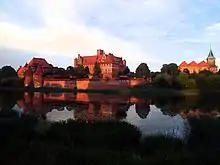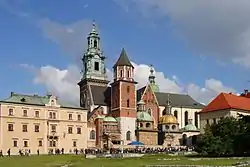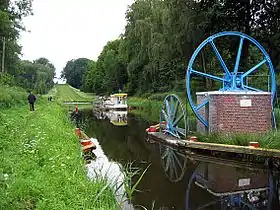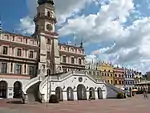Seven Wonders of Poland
The Seven Wonders of Poland (Polish: Siedem cudów Polski) is a short list of cultural wonders located in Poland. The creation of the list was initiated by the leading Polish newspaper Rzeczpospolita in a country-wide plebiscite held in September 2007.[1] The results were published in the following month.[2]
Initially over 400 national monuments were selected as candidates by the magazine online-readers, however in the second round of selections a board of experts reduced the number to 27. The third and last round of public on-line voting started on 31 August 2007, to choose the top seven wonders. Results of the popular vote were announced on 21 September 2007.
| # | Name | Location | Image |
|---|---|---|---|
| 1 | Wieliczka Salt Mine Kopalnia soli Wieliczka UNESCO World Heritage Site | Wieliczka, Lesser Poland |  |
| 2 | Toruń Old Town UNESCO World Heritage Site | Toruń, Kuyavian-Pomeranian Voivodeship |  |
| 3 | Malbork Castle Zamek w Malborku UNESCO World Heritage Site | Malbork, Pomerania |  |
| 4 | Wawel Castle and Cathedral Zamek Królewski na Wawelu | Kraków, Lesser Poland |  |
| 5 | Elbląg Canal Kanał Elbląski | Warmian-Masurian Voivodeship |  |
| 6 | Zamość Old Town UNESCO World Heritage Site | Zamość, Lublin Voivodeship |  |
| 7 | Kraków Market Square and Old Town UNESCO World Heritage Site | Kraków, Lesser Poland |  |
See also
References
- Editorial (September 2007). "Siedem cudów Polski (Seven Wonders of Poland)" (in Polish). Rzeczpospolita. Archived from the original on July 18, 2011. Retrieved December 14, 2012.
- Editorial (October 2007). "Jaskinia pokonała góry - wyniki plebiscytu (Results of the Plebiscite)" (in Polish). Rzeczpospolita. Archived from the original on 2012-12-14. Retrieved December 14, 2012.
This article is issued from Wikipedia. The text is licensed under Creative Commons - Attribution - Sharealike. Additional terms may apply for the media files.
